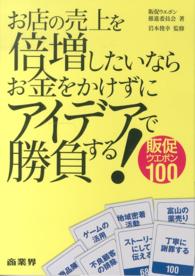- ホーム
- > 洋書
- > 英文書
- > History / World
Full Description
This book traces the fascinating history of how and why ancient Mesoamerican objects have been collected. It begins with the pre-Hispanic antiquities that first entered European collections in the sixteenth century as gifts or seizures, continues through the rise of systematic collecting in Europe and the Americas during the nineteenth and twentieth centuries, and ends in 1940—the start of Europe's art market collapse at the outbreak of World War II and the coinciding genesis of the large-scale art market for pre-Hispanic antiquities in the United States.
Drawing upon archival resources and international museum collections, the contributors analyze the ways shifting patterns of collecting and taste—including how pre-Hispanic objects changed from being viewed as anthropological and scientific curiosities to collectible artworks—have shaped modern academic disciplines as well as public, private, institutional, and nationalistic attitudes toward Mesoamerican art. As many nations across the world demand the return of their cultural patrimony and ancestral heritage, it is essential to examine the historical processes, events, and actors that initially removed so many objects from their countries of origin.
Contents
Introduction: The Art of Ancient Mesoamerica, Collections Forged before
1940 - Mary E. Miller
From the Market to the Museum: Nineteenth-Century Circulation, Display,
and Scholarly Study of Mesoamerican Artifacts in Italy and Beyond - Davide
Domenici
"An Idol, a Human Crane, an Incrusted Frilly Blue Mosaic Work Once Made
for Magic Oracles": Curious Things from Mexico in Early German
Collections, 1525-1835 - Viola König
Ciriaco González Carvajal and Archaeological Collectionism in Late
Bourbon New Spain - Leonardo López Luján
The Objects of History and the History of Objects - Matthew H. Robb
The Chapultepec Castle Chimalli: A Habsburg-Repatriated Aztec Ocelot-
Hide Shield - Laura Filloy Nadal and María Olvido Moreno Guzmán
Collections and Recollections of "the Greatest of Nineteenth-Century Don
Quixotes": Maximilian I's Imperial Legacy in the Yale Peabody Museum -
Brooke Loukkala
Beyond the Bazaar: The Making of the Archaeological Collection at the
National Museum of Mexico - Miruna Achim
National Guardians and Imperial Contenders: The Development of
Mexico's Archaeological Inspectorate - Adam T. Sellen
Lost at the Exposition: The Missing Collection of the First National Museum
of Guatemala - Oswaldo Chinchilla Mazariegos
Casting for Quirigua: Edgar L. Hewett, the School of American Archaeology
and Ancient American Research, 1907-1916 - Khristaan D. Villela
Maya on the Mersey: Thomas Gann and Collecting in Early Twentieth-
Century Britain - Andrew D. Turner
"American Antiquities for an American Museum": Frederick Church, Luigi
Petich, and the Founding Decades of the Metropolitan Museum of Art
(1870-1914) - Joanne Pillsbury
World
Collecting Mesoamerican Art before 1940: A New World of Latin American Antiquities
Imperialist Ambitions, Black Gold, and Stone Figures: Collecting Huastec
Sculptures before 1940 - Kim N. Richter
Branding West Mexico: How Collectors and Dealers Reshaped the
Archaeological Discourse - Christopher S. Beekman
Changing Geographies of the Mesoamerican Antiquities Market circa 1940:
Pierre Matisse and Earl Stendahl - Megan E. O'Neil
Afterword: Object Amnesia and the Archive - Megan E. O'Neil








